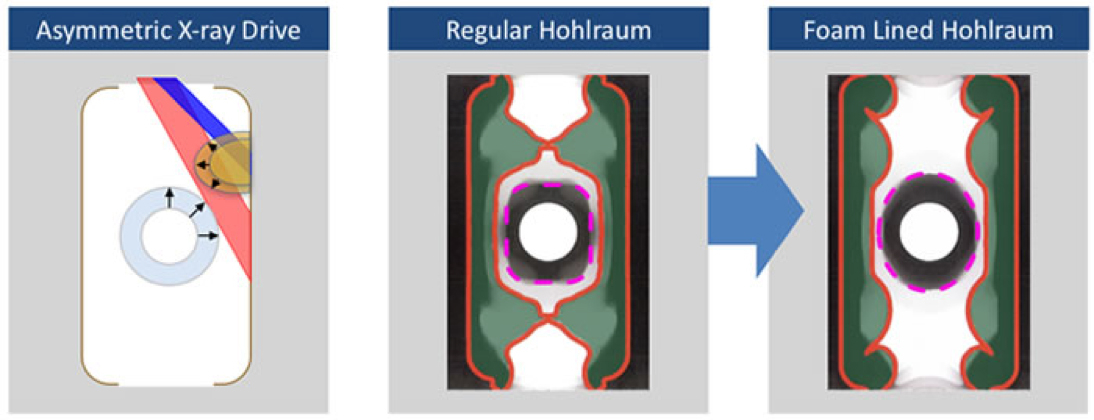NIC seminar focuses on NIF target design
Mention the National Ignition Facility (NIF) and most people think of its 192 laser beamlines housed in a hanger-sized building. But NIF will not be able to live up to its name without a critical component — the target.
John Lindl, chief scientist for NIF programs, described the target design effort in the second National Ignition Campaign (NIC) seminar, held Tuesday morning in the Bldg. 123 auditorium.
"Why do we think that ignition will work on NIF?" he asked. "Because we have more than three decades of experiments with Nova, OMEGA and other lasers that have provided an extensive database. We have benchmarked simulations that give us first-principles descriptions of X-ray target performance. And we have a decade's worth of Halite/Centurion underground experiments using nuclear explosives.
"One of the most challenging requirements for ignition is achieving adequate control of the laser-plasma interaction. We've made dramatic progress in the past four years in modeling laser-plasma interaction in ignition-relevant plasmas. The ASC (Advanced Simulation and Computing) capability has been absolutely crucial to being able to move this forward."
Lindl went on to describe the effort to define the target conditions necessary to achieve ignition.
"There's a tradeoff between target design and the laser energy needed," he noted. The higher the laser energy, the less stringent the target design requirements and vice versa. Based on all the available information and the current specifications on the laser, target and experiments, the ignition experiments that will follow a successful implosion optimization campaign should have a good chance at ignition at the 1- to 1.2-megajoule laser energy planned for the first year of NIF operations.
"An implosion is an inherently unstable process," Lindl explained. The targets consist of a spherical beryllium shell or ablator surrounding the frozen deuterium-tritium (DT) fuel. When X-rays from the hohlraum ablate material from the capsule to drive the fuel inward, hydrodynamic instabilities want to grow at the outer surface of the ablator and at the interface between the ablator and the DT fuel.
"We've spent a huge amount of effort to get smooth surfaces to minimize these instabilities. There's always a tradeoff between a high implosion velocity and the growth of hydrodynamic instabilities."
Lindl also described the methodology that has been developed to assess target design performance margins and uncertainties and the probability of ignition.
"We need to understand margins and uncertainties so we can set specifications for target fabrications, laser performance and other factors. We have to determine the variations that are tolerable."
According to Lindl, the key variables of ignition capsule performance are the velocity of the implosion, the adiabat or compressibility of the DT fuel, the extent of mix at the ablator/fuel interface and the shape of the ignition hotspot. Taken together, these four variables are used to define an Ignition Threshold Factor (ITF).
"We use the ITF to establish the minimum capsule performance needed to achieve ignition," he explained. "We also use the uncertainty in the ITF from shot-to-shot variations and measurement and systematic errors to set specifications for target fabrication, laser performance and experimental precision."
Much of the first year of experiments with NIF will be directed toward optimizing the laser-plasma interaction and key characteristics of an imploding capsule without cryogenic fuel layers. These experiments will determine and refine the 14 laser parameters and three target parameters necessary to optimize the fuel assembly.
These initial experiments will be followed with cryogenic layered experiments, which use a fuel of predominantly tritium with low levels of deuterium. These targets, which are not designed to ignite, will be used to optimize the imploded fuel assembly.
"These targets are designed to be a very good mock-up of the fuel conditions in an igniting target," Lindl explained.
"Because they are designed for low yield, we will be able to optimize the fuel assembly while retaining an extensive suite of diagnostics, which would be adversely affected by large neutron yields. And once we have optimized the fuel assembly, we can then carry out high-yield DT experiments.
"The initial NIC experiments will only scratch the surface of NIF's potential," Lindl said.
"By 2012, we expect to be able to operate at NIF's full design energy of 1.8 megajoules of blue light. Over time, we should be able to improve the robustness and gain of our ignition targets.
"We will explore the possibility of very-high-performance targets using NIF's capability for delivering over 3 megajoules of green light. And there are advanced target concepts such as fast ignition for which NIF will be able to provide definitive answers.
"The next few years are going to be very exciting."







